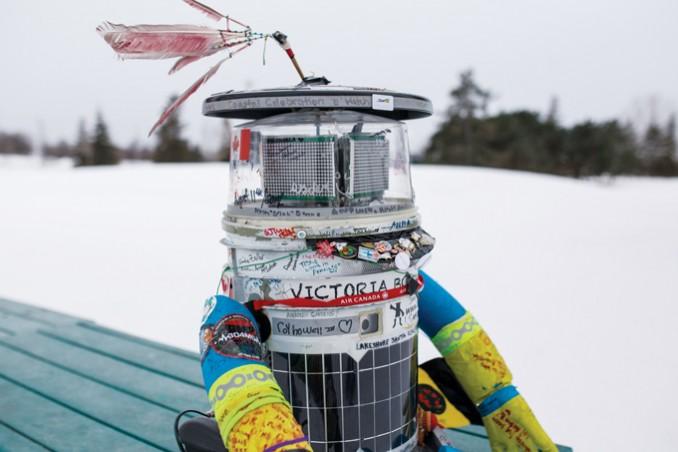By Justin Chandler
HitchBOT, a robot famous for hitchhiking across Canada in 2014, is settling down in the country’s capital. The robot, which is managed through collaboration between Ryerson and McMaster universities, will become part of the Canada Science and Technology Museum’s permanent collection when the Ottawa museum reopens in November 2017.
The robot that will be on display at the museum will be the first HitchBOT, the model that travelled from Halifax to Victoria in 21 days. A second version of the robot, HitchBOT 2.0, was created for international travel. The first model came back from its cross-Canada trip “transformed,” said Frauke Zeller, co-creator of HitchBOT and assistant professor of professional communication at Ryerson. HitchBOT returned from its journey adorned with stickers, jewellery and drawings. “We wanted to preserve that,” said Zeller.
Zeller calls the museum’s request to keep HitchBOT a great compliment. She said she hopes her team can work with the museum to make HitchBOT as engaging in the museum as it was on the road.
“A lot of people think museums look for old things,” said Tom Everrett, curator of communications at the Canada Science and Technology Museum. But he said the museum also likes to collect items that are significant now and will continue to be later.
Everrett said he will work with Smith and Zeller to find an interesting way to integrate the photos HitchBOT took and the metadata it collected into the exhibit. He said a challenge will be keeping HitchBOT accessible so that it can interact with people.
“We didn’t want it to be a funeral,” said Everrett of HitchBOT’s stay in the museum. He said he prefers to call it “active retirement.”
HitchBOT was conceived in 2013 by Zeller and David Harris Smith, assistant professor in the department of communication studies and multimedia at McMaster Uiversity. The robot is managed by Zeller, Smith and about 14 students, half of whom are from Ryerson.
HitchBOT was designed as a social experiment to ask if robots can trust humans. The project reverses the commonly asked question of whether or not humans can trust robots, an important question that “we should never stop asking,” Zeller said.
HitchBOT has a bucket for a torso, blue pool noodles for limbs, yellow gloves for hands and yellow rubber boots for feet. Its head is made up of LED screens and encased in a clear dome. A solar panel wraps around its belly.
The three-foot-tall robot weighs about 25 pounds. It’s designed to be heavy enough to resist wind when sitting by the side of the road, but light enough to be lifted into vehicles. HitchBOT is incapable of moving places on its own. It’s equipped with a camera and 3G internet so it can share photos on social media. The robot charges with solar panels or can be plugged into car lighters for power. Its team can track it via GPS.
After HitchBOT’s successful trip across Canada, the team created a second model. The second HitchBOT had the same look as the original. The only changes were an icon to indicate when it needed recharging and upgrades to its language software.
HitchBOT 2.0 went to Germany for 10 days in February 2015 and the Netherlands for three weeks in June 2015. It was dismembered in Philadelphia in August 2015, just two weeks into its journey across the United States causing sadness and outrage on social media.
Zeller said she and the team were shocked by HitchBOT’s destruction. Before the Canadian tour, people kept asking the team if they were worried something bad would happen to the robot. The team replied that the risk was part of the experiment to learn if robots can trust humans, Zeller said.
But HitchBOT was treated so well in Canada, Germany and the Netherlands that when it went to the United States, Zeller said she was not worried for it.
“When they sent us those images of HitchBOT [with] the arms torn off, it wasn’t nice,” Zeller said.
Because of the substantial amount of time and effort needed to manage HitchBOT, the project has been put on hold, Zeller said. The team will determine what to do next in the spring
“Expectations are so high. It’s not just some little project you can run on a small budget now,” Zeller said.










Leave a Reply